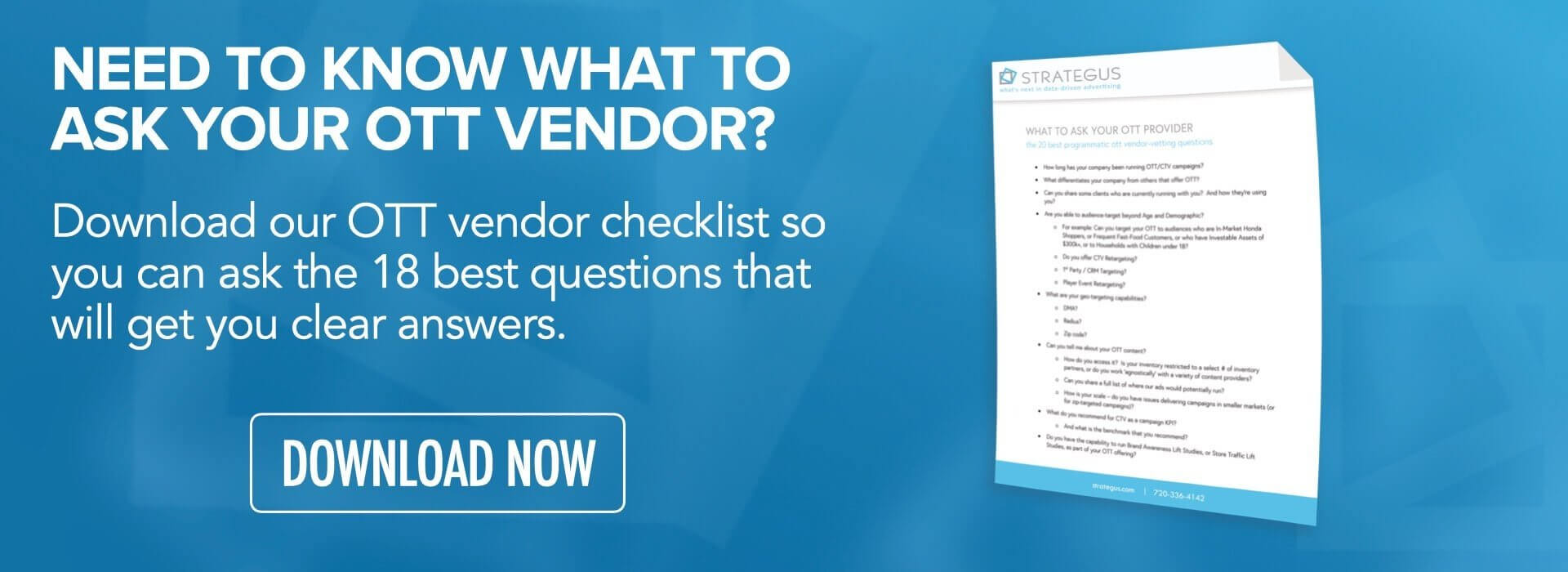- Home
- Strategus Blog
- Three Keys To eCommerce Ads on CTV That Drive Results
Three Keys To eCommerce Ads on CTV That Drive Results
 Andy Dixon
Andy Dixon
8 minutes read

This post on eCommerce ads is part of our larger “OTT/CTV eCommerce Advertising Guide,” click here to learn more.
The rise in eCommerce has exploded since the pandemic began. And it feels pretty safe to say that it’s here to stay. Going backward wouldn’t make much sense for those who have built eCommerce platforms during this New Normal because what a waste of effort! For those looking to take advantage of this rise, not only in eCommerce, but also in CTV purchasing and viewing, connected TV advertising is the perfect segue into marrying these two concepts. The connected TV is one of the biggest digital devices available in a person’s home, so how can you reach them in a way that actually drives results? This new way of doing things often comes with a lot of questions about how, when, where, and again, how?
In May of this year, total online spending was up 77% year-over-year. It would have taken 4 to 6 years to see this kind of growth in a single month based on the growth of previous years, according to an Adobe report.
One of the most common questions that we receive from you, dear marketers, is how can you drive attributable results through eCommerce ads on Connected TV? There’s this myth out there that CTV is all about – only about – building brand awareness, and that you can’t actually convert through CTV ads specifically, because those ads aren’t clickable. Well, let us first share that this is unequivocally not true, and the myth has been proven false time and again by our own hands and algorithms. And second, the myth might be true for some advertisers who aren’t working with the right partners because those partners don’t know any better.

If you would like to learn the three key strategies to eCommerce ads on CTV that actually drive results, then continue reading. There are right ways and wrongs way to advertise on CTV, and we hope to alleviate some of the internal angst that comes from a fear of choosing wrong and seeing your ad spend flop.
1. You have to make CTV eCommerce ads attributable. Typically, this means leveraging a partner that has these capabilities.
Oftentimes when you go directly to content providers like HULU, they don’t include the ability to attribute performance directly to the ad spend (advertising nightmares in a nutshell, right there). They’ll tell you to approach CTV advertising as a “brand awareness” play as we discussed earlier, which might feel like a waste of time and money. Again, we are here to tell you that this belief is fundamentally wrong when it compares to what is possible today.
With the right partner, cross-device tracking and attribution are possible.
And with the right partner, who also happens to have designed a kickass attribution technology like Strategus’s Attribution Suite, you can attribute your ad spend to many different types of eCommerce-focused end results that you can read about below:
- Post-View Website Visit Attribution
- Shows direct engagement on your brand’s website after OTT/CTV ad exposure.
- Online Purchase Attribution
- Tracks users who purchase after OTT/CTV ad exposure. This works for your website/eCommerce shop and Amazon as well.
- After-Ad Influence (AAI)
- Measures consumer pre-purchase intent to research products and services after being influenced by ad exposure.
- And if you happen to have a physical retail location too you can do the following as well:
- Offline Conversion Tracking
- Pinpoints user ad views prior to purchase and maps direct sales according to promotion time and location windows.
- UPC Attribution
- Tracks direct post-view product purchases based on Universal Purchase Code (UPC) barcode.
- Foot-Traffic Attribution
- Tracks physical, offline, cross-device ID into any physical location.
- Offline Conversion Tracking
If you are working with a team that can’t achieve this kind of attribution, that’s ok. We’re all doing our best. And, if you’re ready to work with a team who can take your eCommerce ads on CTV to the next level, let’s talk strategy today!
2. Make your ads actionable — This isn’t Broadcast TV. You can drive post-view actions.
Unlike old broadcast TV, which feels like the equivalent of the televisions of yore with a bulbous glass front that people used to whack with the duck hunt gun, CTV advertising has the power to drive actions like clicks, visits, sign-ups, and so much more. BUT, and that’s a very big but (no, not that kind), you have to be able to retarget people on the devices they’re holding in their hands after they have viewed the ad to completion on their connected TV. Here at Strategus, this is called Encore Omnichannel.
Encore Omnichannel is essentially a way to bring trackable engagement to CTV ads. It allows the viewer to experience a full story arc as opposed to the spray-and-pray type of broadcast marketing of the past. And this is done through retargeting to those handy-dandy in-hand smart devices that many viewers are holding while watching TV.
94% of TV-watchers also have a smartphone in-hand while watching. 94%! (According to this Facebook IQ study.)
While, historically, it’s been difficult to know who saw your ad, this isn’t the case with Strategus and our powerful Encore Omnichannel campaign enhancer. We already know how to serve and track relevant messaging, and once those highly-targeted CTV ads are completed, we can instantly re-target an already engaged viewer with clickable calls-to-action right on their mobile devices, laptops, tablets, and any other smart device that is sitting in front of them.
Another way to make your ads actionable is by delivering sequential messaging (also known as “ad sequencing”). For example, the initial CTV ad might be part A of the story. Then the post-view retargeted ad is part B. Part C could drive them to your website, or encourage some other type of attributable action like clicking a link or filling out a survey.
You can read more about how to create a more fluid messaging campaign across multiple devices in this article.
3. Hyper-targeting is your friend.
Hyper-targeting is the bread and butter of modern advertising. Why waste time and effort throwing ideas into a black hole, hoping something comes back out of it, when you can choose exactly what you want to happen to a specific person at the time of your choosing? And what if each of those choices was made based off of a well of data that was right at your fingertips? Hopefully, you’re saying, “Yes, yes, count me in!”
To truly understand how specific you can get with targeting, it’s important to know that there is a painful amount of data available about every single one of us (unless you’ve lived off-grid in a forest bunker all of your life). Whether we like it or not, all of our smart devices are loaded up with tech that tracks our behavior. And that is just the tip of the iceberg. There are also data scientists, machine learning, and artificial intelligence out there gathering data as well. With all of this information gathering happening all the time, we can narrow your audience down to foods they like to avoid, what time of day they are doing certain activities, where they spend their time and money, and so much more.
Talk about a comprehensive beast of a system to begin creating ideal audience personas. With the right partner, targeting capabilities are as good as, and maybe even better than, many programmatic display options, and they are far better than paid search targeting.
Continue reading for some of the different categories for hyper-targeting. A blended approach is often the best choice, followed by that magic puzzle piece of Encore Omnichannel technology that allows you to make your campaigns clickable.
A few of the hyper-targeting categories include:
- Behavioral Targeting – What are their interests, hobbies, online activities, and so on?
- Time of Day Targeting – When is an individual most active?
- Traditional Geographic And/Or GPS-Based Targeting – Cities, zip codes, and designated market areas are alive and well in the CTV world as well as a more modern approach to geo-targeting which is device GPS based. Feel free to reach and we can talk strategy on how this can be leveraged.
- Automatic Content Recognition (ACR) Targeting – A neat way to target based on the audiences viewing habits on their CTV. Are they watching American Idol, Wimbledon, or other shows that might be too expensive to access at normal times?
- Leverage First-Party Data to Reactivate Dormant Customers in Your CRM – Do you have a bunch of old contacts in your CRM that you are trying to find ways to reactivate without just blasting out email after email and putting your sender reputation at risk? Well, we can take those email addresses and send them targeted ads to get them back into the funnel with a great offer.
This is just the tip of the iceberg when it comes to the power of hyper-targeting, especially when it’s used in conjunction with other strategies that encourage action.
Time is a precious commodity that requires a constant give and take of balance and trust to manage everything. If you’re having to choose between the success and failure of your next ad spend, choose success by partnering with a team that you can trust to handle your business the right way. You can’t always control all of the moving parts of a project, but with Strategus, you can be certain that every choice that’s made is based on a wellspring of data and years of experience.
If you’re ready to talk strategy about your eCommerce ads, fill out this form and we’ll be in touch!


Andy Dixon is a seasoned Content Writing Specialist at Strategus, renowned for his expertise in creating engaging and impactful digital content. With over a decade of experience in content creation, Andy has honed his skills in a variety of niches, ranging from technology and marketing to education.
Strategus is a managed services connected TV(CTV) advertising agency with over 60,000+ campaigns delivered. Find out how our experts can extend your team and drive the result that matter most.
Talk to an Expert
Seeking a Custom CTV Strategy That Delivers?
What to read next

Best SVOD Platforms for Advertisers
The streaming wars have a new battlefront, and this time, it's all about your ad budget. Just a few years ago, SVOD meant "no commercials." Now, it...
12 minutes read

Third-Party Data Targeting for CTV: Benefits & Tactics
Third-party data. It’s a term that’s thrown around, and yet few take the time to detail its pros and cons — much less strategies for using...
7 minutes read

First-Party Data Targeting: Benefits and Tactics for CTV Advertising
First-party data is the information that companies collect directly from their customers rather than through intermediaries. Advertisers use this...
10 minutes read

Foot-Traffic Attribution: Tying Ad Impressions to In-Store Visits
The marketing funnel has changed. Today’s shoppers often begin researching products from the comfort of their homes and don’t set foot into a store...
8 minutes read















